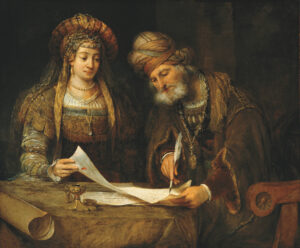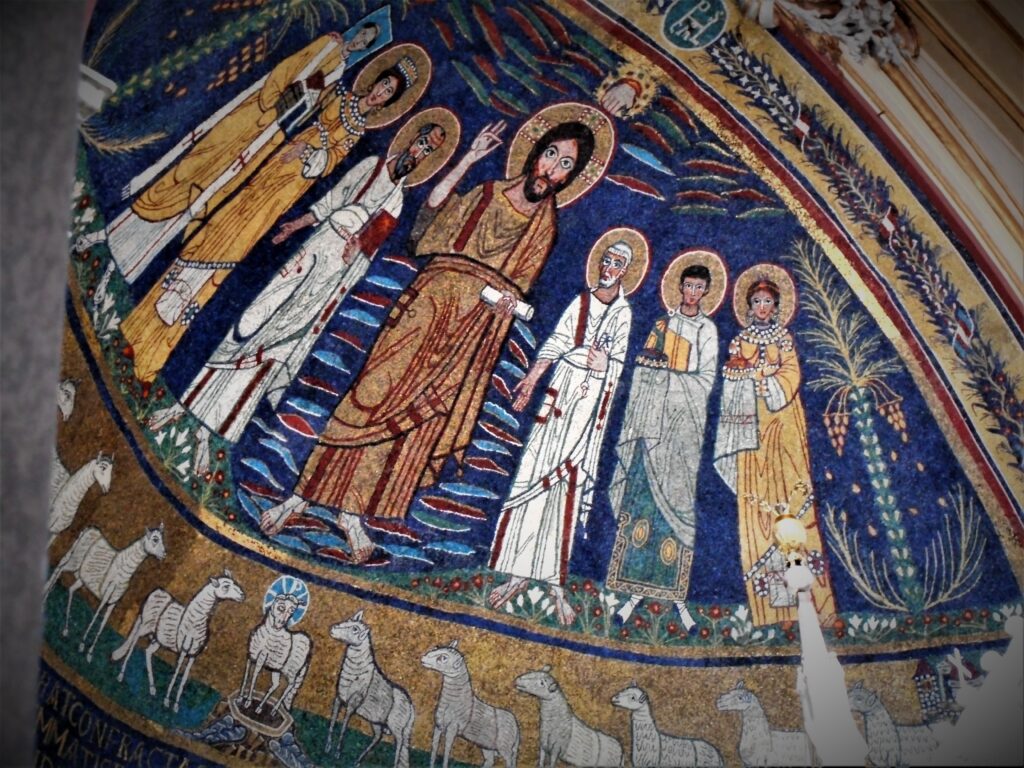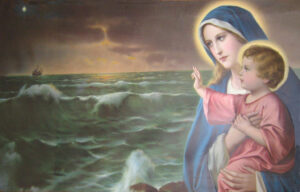Purim and Lent – Esther and Cecilia
by Fr. William Rock, FSSP
As discussed previously, the traditional Roman liturgy preserves, incorporates, and elevates elements of worship from the Old Law, Christianizing them. The connections between the Jewish Passover and the Christian Holy Week and Easter and between the Jewish Pentecost and the Christian Pentecost are perhaps the most well-known, and it was noted that the Ember Days of September incorporate into the worship of the New Law the feasts of Rosh Hashanah (the Jewish New Year, more properly the Feast of Trumpets), Yom Kippur (the Day of Atonement), and Sukkot (the Feast of Tabernacles). All of these feasts were instituted by God during the Exodus and their specifications are found within the Torah, the Books of Moses, the first five books of the Bible.
But there are other Jewish feasts which were established later and not immediately by the command of God. These feasts commemorate important events in the post-Exodus history of the Jewish people. One, Hannukah, celebrated in the winter, marks the rededication of the Jewish Temple under the Maccabees.1

Another Jewish feast, Purim, commemorates the saving of the Jewish exiles in the Persian Empire through the intercession of Queen Esther. It is recorded in the Book of Esther that the Persian King, Assuerus, dismissed his queen because she offended him in front of the dignitaries of the Empire. A quest was then made to find the most beautiful woman in the kingdom to be the new queen, and Esther, a Jewess, was chosen. When later her adopted father and uncle Mardochai learned of a plot by Aman, a court official, to have all the Jews in the kingdom killed by command of the king, Mardochai asked Esther to approach and intercede with the king for their people. This was not without danger, however, as the law stated that any who appeared before the king unsummoned would be immediately killed if the king did not signal clemency with his scepter. After praying, Esther entered the presence of the king. The king granted her mercy and said to her that “this law,” concerning entering the king’s presence, “this law is not made for thee, but for all others” (15:13). Then, through the intercession of Esther, the Jews of the kingdom were saved, and their enemies defeated.
This Feast of Purim is yearly celebrated in February or March. On this feast, the entire Book of Esther is read in the synagogues.2 The only time, in the Roman tradition, when a reading is taken from the Book of Esther during the Temporal Cycle is on the Wednesday after the Second Sunday of Lent, which occurs yearly around the same time as Purim. This year, the Wednesday after the Second Sunday of Lent falls on March 8th, Purim on March 6th-7th. In this way, the Roman Liturgy preserves, incorporates, and elevates, as it were, the celebration of Purim.
The Station, the Roman church where the Pope would celebrate Mass on a given day, chosen for the Mass of the Wednesday after the Second Sunday of Lent, is the church of St. Cecilia in Trastevere. This is worth noting because the “oldest synagogue,” in Rome is “situated in the Trastevere quarter, near the present Church of St. Cecilia.”3 Indeed, “until the first century C.E. the Jewish settlement in Rome occupied the Trastevere section of the city.”4 So the Roman Christians, then, would have had their Liturgical observation of Purim, as it were, near the oldest synagogue in Rome in the area of the city historically associated with the Jews of the diaspora, Jews living outside of the Holy Land. It should be remembered that the events recounted in the Book of Esther took place outside of the Holy Land also.

The choice of the Station of St. Cecilia’s is also fitting as there are similarities between the two women, Esther and Cecilia.5 Both were forced into marriages with pagan men. They both resented the pagan excess of the societies where they lived, Cecilia even singing to God in her heart during the pagan excesses at her wedding. Blessed Ildefonso Schuster, in his Sacramentary, wrote the following: “Truly there was need to say with Mardochai [whose prayer is the Epistle of the Mass on the Wednesday after the Second Sunday of Lent]: ‘Shut not the mouths of them that sing to thee, O Lord our God.’ These words apply also to St. Cecilia – the patron of sacred music – who, whilst the harps of the [marital] banquet sounded in her ears, sang to the Lord in her heart.”6 He also wrote that “the representation of Cecilia, who, adorned with golden ornaments and Byzantine gems, is resplendent in the apsidal mosaic of [Pope] Paschal I [at her church], evokes the memory of Esther imploring from the Persian king the salvation of her people.”7 Similarly, the Gradual and Tract of the Mass, following the Epistle, both have the theme of imploring God to save His people from their enemies.

Beyond bringing forward, as it were, this Jewish Feast into the New Law, there is a fittingness that the Roman Liturgy should reference Esther during Lent. For Queen Esther – whose name means “Star” – is seen as a type, a foreshadowing of Mary, the Queen of Heaven and Earth who cooperated with the King of All for our salvation and whose name has been interpreted to mean “Star of the Sea” (Stella Maris).8 The Church even ascribes the declaration of the King to Esther when she entered his presence to Our Lady in support of her Immaculate Conception – “this law,” concerning the inheritance of Original Sin, “this law is not made for thee, but for all others.”
Writing in the mid-1800s, Dom Prosper Guéranger wrote the following as a commentary for the Epistle of the Wednesday after the Second Sunday of Lent in his Liturgical Year:
This petition, which Mardochai presented to God in favour of a whole nation that was doomed to destruction, represents the prayers which the saints of the old Testament offered for the salvation of the world. The human race was, to a great extent, in the power of satan, who is figured by Aman. The almighty King had given sentence against mankind: ‘Ye shall die the death.’ Who was there that could induce Him to revoke the sentence? Esther made intercession with Assuerus, her lord; and she was heard. Mary presented herself before the throne of the eternal God: and it is she that, by her divine Son, crushes the head of the serpent, who was to have tormented us for ever. The sentence, then, is to be annulled; all shall live that wish to live.9
Let us then, dear reader, always give thanks to God for bringing His faithful, by means of these traditional liturgies of the Roman Church, into communion with not just our Catholic forefathers, but also those Jews and Hebrews who looked forward to the coming of the Messiah, and all those who worshiped the One, True God in spirit and in truth, even back to Adam and Eve in Eden. Glorious and great is our heritage! And let us also be thankful for having been given such a great Intercessor, Queen, and Lady, Mary, the true Esther, the Star of the Sea.
William Rock, FSSP was ordained in the fall of 2019 and is currently assigned to Regina Caeli Parish in Houston, TX.
- The Feast of Hannukah, also known as the Feast of the Dedication, is explicitly mentioned in the New Testament in the tenth chapter of John’s Gospel which recounts Our Lord’s activities in Jerusalem during this feast. This account was selected to be the Gospel of the Mass of the Wednesday of Passion Week (John 10:22-38). Even though Hannukah takes place in the November-December timeframe, and the Gospel pericope of Passion Week states that the related events took place during the winter, the Liturgical Year does not place it then, the Wednesday of Passion Week always falling around the Spring Equinox. There is, however, a fittingness of having this Gospel read during Passion Week as it captures the growing hostility against Our Lord as He approaches His Passion and Death. There is not currently in the Roman Liturgical books any explicit mention to the Feast of the Dedication in the time leading up to Christmas, but perhaps the Postcommunion of the First Sunday of Advent, in which the Church askes “May we receive Thy mercy, O Lord, in the midst of Thy Temple,” was influenced by its proximity to the Feast of Hannukah. Also, the Fourth Lesson of Ember Saturday of Advent is Isaiah’s prophecy of Cyrus, King of Persia, who would end the 70-year Jewish Exile in Babylon and charge them to rebuild the Temple, the same Temple the Maccabees rededicated.
- Old Catholic Encyclopedia, s.v. Purim.
- Jewish Encyclopedia, s.v. Rome.
- Ibid.
- See Facebook post by Benedicamus Domino (here). This post was the inspiration for this article. The connection between Purim and the Wednesday after the Second Sunday of Lent is also noted by Alisa Kunitz-Dick in her article.
- Schuster, Ildefonso. The Sacramentary, vol. II. Trans. Levelis-Marke, Arthur. (Waterloo: Arouca Press, 2020), pp.85-86.
- Ibid., p. 85.
- Old Catholic Encyclopedia, s.v. The Name of Mary.
- Guéranger, Prosper. The Liturgical Year, 5 (Lent). Trans. Shepherd, Laurence. (Fitzwilliam: Loreto Publications, 2000), p. 215.
March 8, 2023








